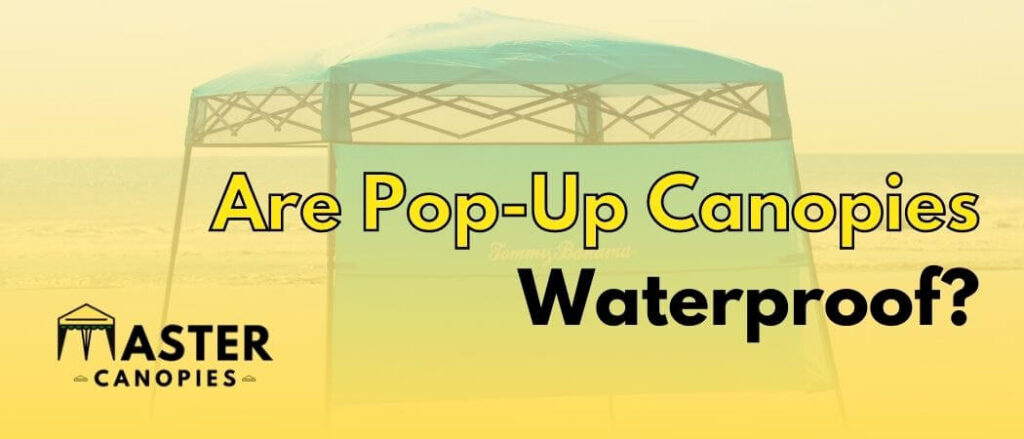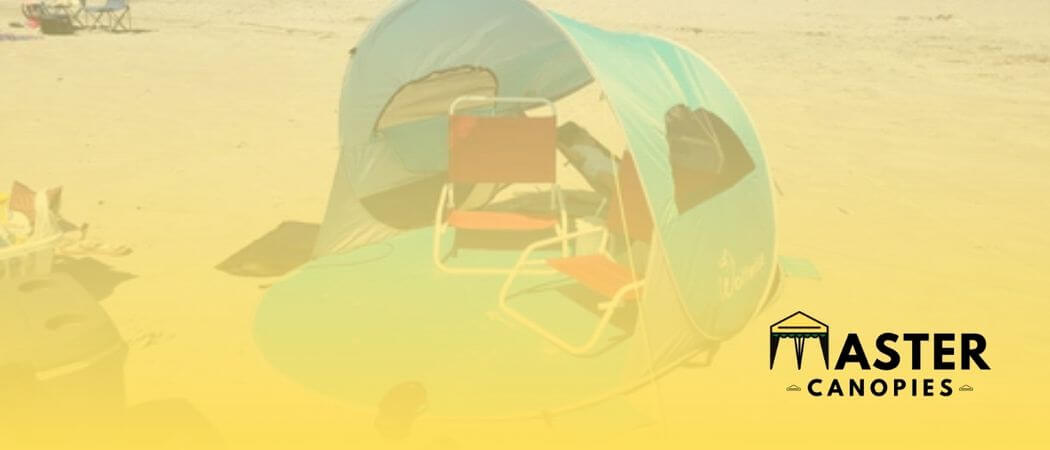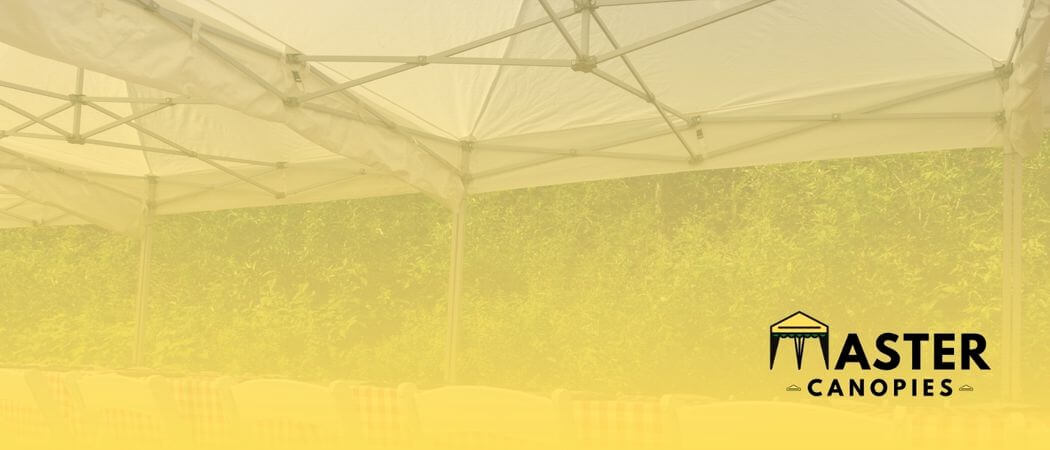
Can You Put a Tent in the Dryer Safely?
Can You Put a Tent in the Dryer Safely? Published February 4th, 2023 by Allen Campbell Well, it’s no secret that a tent is a
Published June 1st, 2022 by Allen Campbell

A pop-up canopy is handy for a wide variety of situations, including baseball games, visits to the beach, and camping excursions, to protect you from the scorching sun and rain. So wherever you go, you might want to take one of these portable umbrellas along.
Many of them come with features like mosquito netting, sidewalls, and wheels to make them more portable. In addition, the finest pop-up canopies are easy to assemble, can resist inclement weather, and fold up into a space-saving size compatible with most vehicles’ trunks.
But an important question arises: Are pop-up canopies waterproof? And if they are, what is the extent to which they can withstand water?
Pop-up canopies are often classified based on the materials they are made of. The most frequently used types of plastic are polyethylene, polyurethane, polyester, and vinyl. Every material has both advantages and disadvantages, one of the disadvantages being a more significant price point for some materials.
The material used for the canopy will be guided in part by its function and the way it is used most often.
Canopies that are long-lasting and resistant to the harsh conditions are often made from polyethylene, a popular form of plastic used to make plastic bags and bottles. However, while being waterproof and offering protection from UV rays, it is not too heavy.
The manufacturer often treats canopies made of polyethylene with a chemical that acts as a flame retardant since polyethylene may catch fire.
Canopies made of polyethylene are convenient for those outdoor enthusiasts who often need to carry their canopies along with them.
In addition, canopies of this kind would be helpful for various people, including those who like camping and people who sell goods outside. Some variants provide an additional layer of defense by including sidewalls.
A polyurethane resin coating is often applied to canopies by manufacturers. This coating offers additional protection from the sunlight and water. In most cases, the coat is made out of polyester or strong canvas.
While polyurethane does contribute some weight, in general, canopies made of polyurethane are lighter than vinyl ones. This material strikes a good mix between affordability and durability. It is often more affordable than canopies made of polyethylene or vinyl.
Polyester is resistant to water and gives some UV protection, albeit not as much as polyethylene, polyurethane, or vinyl. Polyester does, however, provide some protection against water.
This material is not only lightweight but also somewhat sturdy. It can be compressed into a compact packaging size making it easier to transport. And not to forget, their prices are quite reasonable too.
The material is often treated with vinyl resin by the manufacturers of canopies to offer waterproofing and UV protection. But, of course, waterproofing keeps you dry.
UV protection shields the material from the sun’s damaging rays, which may cause it to fade, rip, and otherwise degrade. The exceptional durability of vinyl makes it a popular material for use in the production of wedding tents, canopies, and pop-ups intended for more permanent usage.
Canopies made of polyethylene, polyurethane, or polyester are easier to fold and transport to trade exhibitions and sporting events than canopies made of vinyl, which has the disadvantage of being much more substantial.
There is a wide variety of sizes available for pop-up canopies, ranging from little versions measuring just 4 feet by 4 feet to wedding canopies that measure well over 10 feet by 20 feet.
Nevertheless, size is not the only thing to take into consideration. You should think about what you need to do to put it up and what attachments are available if its size and weight make it difficult to move it. You should also think about what you need to do to transfer it.
Canopies are available in a wide variety of sizes. The majority of them are either square or rectangular in form. The smallest types are approximately 4 feet by 4 feet in size. They are meant to provide shade for a single individual or to function as something similar to a portable change station for toddlers while traveling.
Pop-ups usually measure 10 feet by 20 feet in size and are designed for weddings and other outdoor events. When you need a larger canopy, you go beyond the area of pop-up canopies and into the realm of pole tents. So, naturally, the amount of room required to carry and store the pop-up will increase in proportion to the pop-up size.
The amount of shade a pop-up canopy gives is determined by the way it was designed by the manufacturer. Canopies that have tall legs and peaks on their covers provide more vertical space, but they leave the sides of the structure more exposed, allowing rain, snow, and sun to pour in.
Some variants come with one or two sides (walls) already attached. In contrast, others feature connection points for sidewalls that may be purchased separately. Some versions do not come with any sidewall customization choices. Pop-up canopies for camping often come equipped with bug netting on the sides, allowing campers to relax or dine without being bothered by pesky insects.
The majority of pop-up canopies have the shape of either a square or a rectangle. On the other hand, other versions come in odd forms, such as hexagons or octagons. Some are designed to look like umbrellas and come with tie-downs and pegs to keep them in place.
Some types are shaped like half-dome tents and provide shade without obstructing the user’s line of sight.
Most pop-up canopies are equipped with tie-downs and stakes, allowing the user to safely anchor a canopy to the ground. Certain variants come with weighted bags or sandbags that help keep the canopy in place.
Some models that are intended to be used on beaches may include stakes that have been modified so that they may dig deeper into the sand for increased stability.
Some of the most lightweight types may consist of little more than a single central pole with a canopy that is held down by a number of stakes, creating a less elegant but very portable canopy.
Most of the time, manufacturers of lightweight frames will create them out of aluminum, while manufacturers of heavier-duty canopy frames would often use powder-coated steel. You may want to balance how much something weighs and how easily it can be carried.
A lightweight aluminum frame can resist most basic usage, making it ideal for outings to the beach with the family. The heavier the frame, the more likely it is that it will be sturdy. However, heavier frames are more costly, difficult to move, and may take more than one person to assemble.
Manufacturers of canopies often utilize cover materials that include some degree of resistance to water. If you want the polyester’s toughness to be maintained, you may need to spray it with a waterproofing agent.
Additional water resistance and protection against UV rays are offered by polyethylene, polyurethane, and vinyl. In most cases, there won’t be a problem with leaks during rainstorms; nevertheless, if water collects under a polyester canopy, this might happen.
Because of the higher ceilings, using the canopy does not need you to hunch over. The ceiling height of canopies explicitly created for usage at events is generally between five and twelve feet.
Many of the models also contain legs that can be adjusted, giving the user anywhere from three to five different height settings. For example, canopies used for camping that resemble the appearance of tents have lower ceilings that measure six feet.
Some canopies come with carrying bags that include straps or handles so that the canopy may be moved around easily. Some of the heavier types come with carrying bags or frames that have wheels connected to them to make it easier to move the canopy into position.
Polyester canopies are often priced at the lower end of the price range, whereas canopies made of polyethylene, polyurethane, and vinyl are priced at the higher end of the price range.
The price of the canopy will, of course, go up if you purchase additional accessories like sidewalls, carrying bags with wheels, and sandbags.
There is no clear-cut answer to the question of whether or not pop-up canopies are waterproof. It all depends on the specific canopy. Some types of canopies from different manufacturers are waterproof while others are not.
The materials that are waterproof are talked about in this article. There is no absolute answer to the question, it all comes down to the pop-up canopy that you’re using. I hope this article adds to your knowledge.

Allen is a full time writer at Mastercanopies.com and enjoys traveling around the United States and exploring nature. He enjoys writing about canopies as he believes they are extremely crucial in having a successful camping trip whether it be a trip to the beach, mountains, or the open plains.

Can You Put a Tent in the Dryer Safely? Published February 4th, 2023 by Allen Campbell Well, it’s no secret that a tent is a

How to Print on a Canopy: How to Print Custom Images/Logos Published February 4th, 2023 by Allen Campbell Do you want to print something special

How to Choose the Best Outdoor Event Flooring for your Next Celebration Published January 31st, 2023 by Allen Campbell Planning an outdoor event can be

How to Insulate a Tent for Winter and Keep Warm Published February 3rd, 2023 by Allen Campbell Is your tent the last frontier when it

Wolfwise Beach Tent Review: Should You Buy It? Published January 23rd, 2023 by Allen Campbell Are you planning a beach vacation but don’t know exactly

How to Start a Tent Rental Business (and have Success with It!) Published January 23rd, 2023 by Allen Campbell Do you have a knack for

Wolfwise Beach Tent Instructions: Easy Setup Guide Published January 23rd, 2023 by Allen Campbell Let’s face it, setting up a beach tent can be tricky…

Best 100×100 Tents for Large Gatherings and Parties Published January 12th, 2023 by Allen Campbell Finding the right tent for your next event can be

Best Tent Rentals in Downers Grove, IL Published January 12th, 2023 by Allen Campbell Hoping to make a big impact in Downers Grove? Well, if

Master Canopies is here to bring you the best canopies for the outdoors so that you can enjoy the fresh air without the gleaming and burning light of the sun.

Master Canopies is here to bring you the best canopies for the outdoors so that you can enjoy the fresh air without the gleaming and burning light of the sun. As an Amazon Associate, we earn from qualifying purchases.